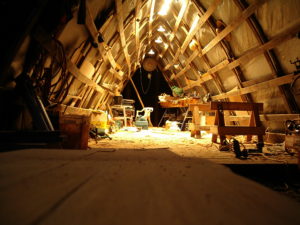
Equipment
If you plan on cutting the frame yourself, I would strongly suggest investing in a new or used machine with hydraulics to save your back and muscles. We were able to find a used backhoe which helped significantly in the clearing and foundation stages, and also moving timbers around too (though it was a bit cumbersome due to size). If you do not need anything for clearing, then a skid steer with forklifts may be more useful (and a little easier to maneuver).
For moving wood small distances, a timber cart is well worth the investment. It is a 2 wheeled cart with a rest for the timber in the middle that is very nimble and easy to use. I would also suggest making multiple sets of saw horses. These will give you ample working space and make it easier to move timbers around, especially if you are working on several at a time.
Workspace
Assuming you don’t have a workshop, tents work well for the actual cutting of the frame. We invested in (2) 10’x20’ and one 12’x36’ tents to cut the frame. The first 2 were purchased from Sams Club and the larger one was a handmade A frame with a large tarp as the roof. All were inexpensive, fast, and dry working spaces. If you have access to some old wood, making an inexpensive platform floor makes it even easier to move around. Otherwise, I would suggest putting down mulch to lessen the mud impact from heavy rains.
As far as inside the workspace, I would strongly suggest a bit of organization and good tools. We made piece drawings for every single timber so that the measurements were checked ahead of time and only needed to be cut once. We also allotted a bit of time each afternoon to cleaning up the workspace and readying it for the next day. Last, we bought good quality chisels and kept them sharp. Being able to start each new day with good drawings, a clean workspace, and sharp tools made our time cutting the frame that much more productive.
I am planning to build one or two A Frame tents for storage and building. As the site is remote I won’t have access to mulch. I was wondering about buying plastic walkway or driveway pads. The ones that allow water to drain thru and grass to grow thru.
They can handle a truck driving on them so they should be more that strong enough to handle a timber cart or log arch driving over them.
Any thoughts on using those as a temporary floor in the shop?
Yes that will be strong enough, I would personally just try and use a dirt floor if the grade is right for it.
I can move the wood (tractor with forks), I’m confident I can do the joinery (I work every day doing mortise and tenon woodworking, albeit on a smaller scale), I might even be able to deal with the building department and all the steel pins they’ll make me put in there and subsequent cost (seismic zone 3), but what gives me real pause is the raising – the ultimate material handling. Don’t feel confident/competent with that at all.
The key for me has always been the preassembly of all the joints. That makes the raising go well. How can we help?
I built a 20’x24′ timber frame pavilion and did all the joinery and material handling myself. Moved all of the beams around in my garage with the aid of a dolly, pry bar, wood blocks, dowels, and two 5:1 block and tackle rigs. Working with a good pair of sawhorses and moving timbers using leverage is the key. The timbers for the ridge beam and plate beams were 8″x12″x24′ long and weighed in at well over 350lbs (eastern white pine; green). If i can do it you can as well.
Thank you Bruce.
I’m reluctant to just go with dirt because the ground is mostly clay. If it gets wet the mud is horrendous. I need something as a floor but I don’t want to build a wood floor either. My thought was that the plastic pieces could be used more than once if I needed. I’ve done wood walkways before to deal with mud. They don’t last much more than a couple years.
Thanks for your input, very helpful!